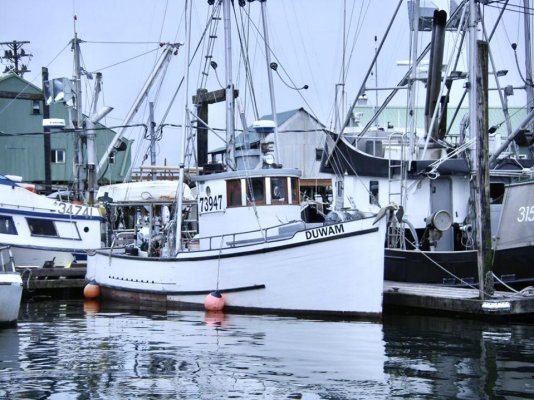Captain DJ
Senior Member
- Joined
- May 18, 2016
- Messages
- 169
- Location
- United States
- Vessel Name
- m/v "Ramble On"
- Vessel Make
- Cheoy Lee 34
If I remember right, the blowers produce about 6psi at full rpm. Normally a turbo Detroit has a lower compression ratio. With turbos on a natural you'd get much higher temps and combustion would be much hotter, shortening the time between overhauls, maybe burning valves and injector tips. And with smaller injector, a much lower fuel/air ratio. Fuel is part of the cooling. Fuel is passing thru the injectors all the time, cooling the tips between firings. And even though the fuel is heated from passing thru the head, it's 1000° cooler than the piston tops. And with smaller injectors you get some lesser amount of cooling. My experience with smaller injectors is loss of higher rpm. The governor doesn't know what injector is installed, so it just opens the injector as far as it can until it's wide open. It still takes fuel to create hp.
The nice thing about naturals is long life, at least 3x longer than turbo models. It probably costs a lot more to rebuild the engine than buying more fuel.
I get better mileage out of my engines by adjusting each cylinder to have the same exhaust temp by how I adjust the rockers, and I use a fuel conditioner (archoil AR6200) that does the usual stuff, but also makes the fuel combust better and gives me 6-10% better fuel economy depending on how much conditioner I use. And I have self made hydrogen generators that break down water into 2 hydrogen, 1 oxygen molecules that is fed into the intake. The hydrogen is additional fuel and the oxygen improves the burn. That gives more than another 10% improvement. So while I should be burning 6 gallons/hour per engine at 1800, I burn a little less than 4.25 gallons/hour. If I did the math right, about 30% better mileage.
I would REALLY like to learn more about the hydrogen generator.
I had 4-53s with the smallest injectors and they were FINE engines. Now I have Ford Lehman 120s and miss my old DDs.
With a 40 gallon/40 inch high Day Tank(with sight gauges) I used 1.35 gallons per hour/engine or 2.7/hr for a GB42-125 woodie. (at 1450 rpms, flat water and 6.75 knots) using magnets on fuel lines and 2 micron pre-cleaned fuel, frequent oil changes and a Lucas Oil additive. They purred. I named them Jake and Bertha. Now these FL120s (unnamed as of yet) throw a sheen on startup and according to FloScan gauges use about 2.5 to 3.1 gallons/hr each (at 1800 rpm and 7 knts), and on a much smaller FG boat...I have only had her one season and am hoping the FloScan meters are just out of calibration or something. I always like the KISS approach of a verifiable Day Tank for pre-cleaned fuel to come from and return to, so I will know each day what was really used.
I have always enjoyed and appreciated your input and knowledge you share on this forum. Please keep it going pal.
Best regards,
DJ
Last edited:

 ford
ford 